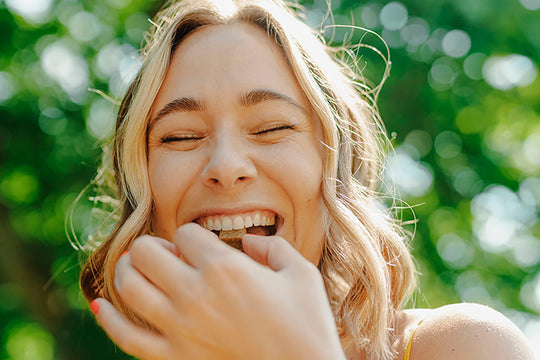Kanna is becoming increasingly popular in the West to support anxiety and depression. However, if you're considering taking Kanna, you might wonder how long its effects will last and how long it will stay in your system.
The duration of Kanna's effects and the length of time it stays in your system can depend on various factors, such as the dose, method of ingestion and individual body chemistry. Let’s look at the factors that can affect how long Kanna stays in your system and what you can expect regarding its effects and potential side effects.
Whether you're new to Kanna or a regular user, understanding its effects and how long they last can help you make informed decisions about using this herbal supplement.
Kanna's effects on the body
Kanna is a succulent native to South Africa and Namibia and revered for its positive effects on the body and mind. There are two major chemical reasons Kanna is uniquely able to play “biojazz” with our brains and bods. The first is its alkaloid content. Found primarily in plants, alkaloids are a class of organic compounds that have a wide variety of physiological effects on humans and other animals. While most plants only have a few alkaloids, Kanna has at least 35(!!) that we know of. In addition to Kanna’s buffet of alkaloids, unlike most plants that target a single type of receptor to displace or block chemicals when we ingest them, Kanna is able to target multiple neuroreceptors responsible for multiple functions. KA!pow!
Through the gentle guidance of its alkaloids and phytochemical compounds and its ability to rock numerous receptors, Kanna can bring about the following:
- Deep relaxation, ease and calm
- Uplifted spirit
- Reduced stress and anxiety1
- Improved mood2
- Increased focus and productivity3
- Boosted energy levels4
- Improved endurance
- Unlocked doors to creativity and problem-solving
- Improved sleep quality5
- Curbed excessive cravings without impeding normal hunger6
But Kanna's magic doesn't end there. It also may have the unique ability to aid individuals struggling with conditions such as ADHD7 and early Alzheimer’s dementia8. It is also an empathogen9 (increases feelings of empathy and connection), a euphoriant10 (produces feelings of joy), an anxiolytic11 (releases stress and tension), an adaptogen12 (regulates your nervous system) a nootropic13 (protects and ups your brain health), an aphrodisiac14(we know you know this one), a hypnotic (induces healthy, natural sleep) and is ergogenic (enhances physical performance, stamina). Plus it has anti-inflammatory, antioxidant, antimicrobial, and immunomodulatory properties15
Though its gifts are many, Kanna is non-addictive, non-toxic, sober and safe. Kanna is a gentle and benevolent teacher, helping individuals find balance and harmony within themselves.
How Kanna is metabolized

As Kanna is metabolized in the liver, it undergoes a transformation process that allows it to be eliminated from the body through urine and feces. While the specific mechanisms involved in Kanna's hepatic metabolism are not fully understood, we know enzymes transform the alkaloids into safe and inert metabolites.
It is important to note that the metabolization of Kanna can be influenced by other substances in the body, which highlights the importance of taking a holistic and mindful approach to its use. By honoring the spiritual essence of Kanna and treating it with reverence and respect, we can unlock its full potential and experience its benefits.
How long do Kanna's effects last?
The felt effects of Kanna can last anywhere from 2 to 13 hours in the waking state and even up to 24 hours if the effects extend into a sleep cycle. In general, the effects of Kanna are relatively short-lived compared to other psychoactive substances. Kanna’s half life (meaning, half of the substance is out of the body) within 24 to 27 hours and it is 99% eliminated from the body within 2 to 4 days.
It's also worth mentioning that both the dosage and method of consumption of Kanna play a role in how long its effects last. Higher doses are likely to produce stronger and longer-lasting effects, while lower doses may have a more subtle and shorter-lived impact.
And, smoking or vaporizing Kanna may produce a more rapid onset of effects but a shorter duration, while consuming it orally may result in a slower onset of effects but a longer duration.
Feel Yourself
While Kanna's immediate effects can last between 2 to 24 hours Kanna's power lingers and continues to impact us even after it leaves our bodies. The practice is to take what we have learned during our time with Kanna and use it in our everyday lives to find deeper connection and acceptance and to be in more integral relationship with ourselves, others and the divine. Because that is what we are here to do!
If you're ready to connect with Kanna, check out KA! Empathogenics' Kanna Chews and Kanna Tincture. Our blends are made with high-quality ingredients and inspired by the healing wisdom of South African and other indigenous communities around the world.
CONTRAINDICATIONS: Do not use Kanna or KA! products in conjunction with Monoamine Oxidase Inhibitors (MAOIs), Selective Serotonin Reuptake Inhibitors (SSRIs), Serotonin-Norepinephrine Reuptake inhibitors (SNRIs), Norepinephrine and Dopamine Reuptake Inhibitors (NDRI's), Benzodiazepines or Central Nervous System (CNS) depressants without medical supervision by a qualified healthcare professional. If you are currently taking prescription medications or have any pre-existing medical conditions, please speak with your doctor or healthcare professional before using Kanna or KA! Never disregard professional medical advice or delay in seeking professional advice because of something you have read here or on the website.
Disclaimers: Any content in this article and the KA! Empathogenics website is for educational and product information purposes only and is not intended as a substitute for medical advice. Information and statements regarding herbal supplements in this article and on the website have not been evaluated by the Food and Drug Administration and are not intended to diagnose, treat, cure, or prevent any disease.
1 Gericke J. Ph.D. Thesis. North-West University; Potchefstroom, South-Africa: 2019. Evaluating the Antidepressant-Like Properties of Sceletium Tortuosum, Alone and as Adjunctive Treatment; Carpenter, J. M., Jourdan, M. K., Fountain, E. M., Ali, Z., Abe, N., Khan, I. A., & Sufka, K. J. (2016). The effects of sceletium tortuosum (L.) N.E. br. extract fraction in the chick anxiety-depression model. Journal of Ethnopharmacology, 193, 329–332. https://doi.org/10.1016/j.jep.2016.08.019
2 Gericke, N., & Viljoen, A. M. (2008). Sceletium—a review update. Journal of Ethnopharmacology, 119(3), 653–663. https://doi.org/10.1016/j.jep.2008.07.043
3 Brendler, T., Brinckmann, J. A., Feiter, U., Gericke, N., Lang, L., Pozharitskaya, O. N., Shikov, A. N., Smith, M., & Wyk, B.-E. V. (2021). Sceletium for managing anxiety, depression and cognitive impairment: A traditional herbal medicine in modern-day regulatory systems. Current Neuropharmacology, 19(9), 1384–1400. https://doi.org/10.2174/1570159x19666210215124737
4 Terburg, D., Syal, S., Rosenberger, L. A., Heany, S., Phillips, N., Gericke, N., Stein, D. J., & van Honk, J. (2013). Acute effects of sceletium tortuosum (zembrin), a dual 5-HT reuptake and PDE4 inhibitor, in the human amygdala and its connection to the hypothalamus. Neuropsychopharmacology, 38(13), 2708–2716. https://doi.org/10.1038/npp.2013.183; Manganyi, M. C., Bezuidenhout, C. C., Regnier, T., & Ateba, C. N. (2021). A chewable cure “Kanna”: Biological and Pharmaceutical Properties of Sceletium tortuosum. Molecules, 26(9), 2557. https://doi.org/10.3390/molecules26092557; Carpenter, J. M., Jourdan, M. K., Fountain, E. M., Ali, Z., Abe, N., Khan, I. A., & Sufka, K. J. (2016). The effects of sceletium tortuosum (L.) N.E. br. extract fraction in the chick anxiety-depression model. Journal of Ethnopharmacology, 193, 329–332. https://doi.org/10.1016/j.jep.2016.08.019
5 Luo Yangwen, Wen Jing, Kanfer Isadore, Yu Pei, Patnala Srinivas. Sceletium Tortuosum: Effects on Central Nervous System and Related Disease. Journal of Pharmaceutical and Biomedical Sciences. 2020 Jun; 10(6): 151-160
6 Bennett, A. C., Van Camp, A., López, V., & Smith, C. (2018). Sceletium tortuosum may delay chronic disease progression via alkaloid-dependent antioxidant or anti-inflammatory action. Journal of Physiology and Biochemistry, 74(4), 539–547. https://doi.org/10.1007/s13105-018-0620-6; Manganyi, M. C., Bezuidenhout, C. C., Regnier, T., & Ateba, C. N. (2021). A chewable cure “Kanna”: Biological and Pharmaceutical Properties of Sceletium tortuosum. Molecules, 26(9), 2557. https://doi.org/10.3390/molecules26092557;
7 Dimpfel, W., Gericke, N., Suliman, S., & Chiegoua Dipah, G. N. (2016). Psychophysiological effects of Zembrin using quantitative EEG source density in combination with eye-tracking in 60 healthy subjects. A double-blind, randomized, placebo-controlled, 3-armed study with parallel design. Neuroscience and Medicine, 07(03), 114–132. https://doi.org/10.4236/nm.2016.73013
8 Chiu, S., Gericke, N., Farina-Woodbury, M., Badmaev, V., Raheb, H., Terpstra, K., Antongiorgi, J., Bureau, Y., Cernovsky, Z., Hou, J., Sanchez, V., Williams, M., Copen, J., Husni, M., & Goble, L. (2014). Proof-of-concept randomized controlled study of cognition effects of the proprietary extract sceletium tortuosum(zembrin) targeting phosphodiesterase-4 in cognitively healthy subjects: Implications for alzheimer’s dementia. Evidence-Based Complementary and Alternative Medicine, 2014, 1–9. https://doi.org/10.1155/2014/682014
9 Siegel, J. Z., & Crockett, M. J. (2013). How serotonin shapes moral judgment and behavior. Annals of the New York Academy of Sciences, 1299(1), 42–51. https://doi.org/10.1111/nyas.
10Gericke, N., & Viljoen, A. M. (2008). Sceletium—a review update. Journal of Ethnopharmacology, 119(3), 653–663. https://doi.org/10.1016/j.jep.2008.07.043
11Gericke J. Ph.D. Thesis. North-West University; Potchefstroom, South-Africa: 2019. Evaluating the Antidepressant-Like Properties of Sceletium Tortuosum, Alone and as Adjunctive Treatment; Carpenter, J. M., Jourdan, M. K., Fountain, E. M., Ali, Z., Abe, N., Khan, I. A., & Sufka, K. J. (2016). The effects of sceletium tortuosum (L.) N.E. br. extract fraction in the chick anxiety-depression model. Journal of Ethnopharmacology, 193, 329–332. https://doi.org/10.1016/j.jep.2016.08.019
12Luo Yangwen, Wen Jing, Kanfer Isadore, Yu Pei, Patnala Srinivas. Sceletium Tortuosum: Effects on Central Nervous System and Related Disease. Journal of Pharmaceutical and Biomedical Sciences. 2020 Jun; 10(6): 151-160
13Brendler, T., Brinckmann, J. A., Feiter, U., Gericke, N., Lang, L., Pozharitskaya, O. N., Shikov, A. N., Smith, M., & Wyk, B.-E. V. (2021). Sceletium for managing anxiety, depression and cognitive impairment: A traditional herbal medicine in modern-day regulatory systems. Current Neuropharmacology, 19(9), 1384–1400. https://doi.org/10.2174/1570159x19666210215124737
14Brunetti, P., Lo Faro, A. F., Tini, A., Busardò, F. P., & Carlier, J. (2020). Pharmacology of herbal sexual enhancers: A review of psychiatric and neurological adverse effects. Pharmaceuticals, 13(10), 309. https://doi.org/10.3390/ph13100309
15Bennett, A. C., Van Camp, A., López, V., & Smith, C. (2018). Sceletium tortuosum may delay chronic disease progression via alkaloid-dependent antioxidant or anti-inflammatory action. Journal of Physiology and Biochemistry, 74(4), 539–547. https://doi.org/10.1007/s13105-018-0620-6; Manganyi, M. C., Bezuidenhout, C. C., Regnier, T., & Ateba, C. N. (2021). A chewable cure “Kanna”: Biological and Pharmaceutical Properties of Sceletium tortuosum. Molecules, 26(9), 2557. https://doi.org/10.3390/molecules26092557;

